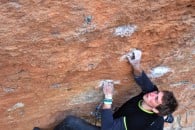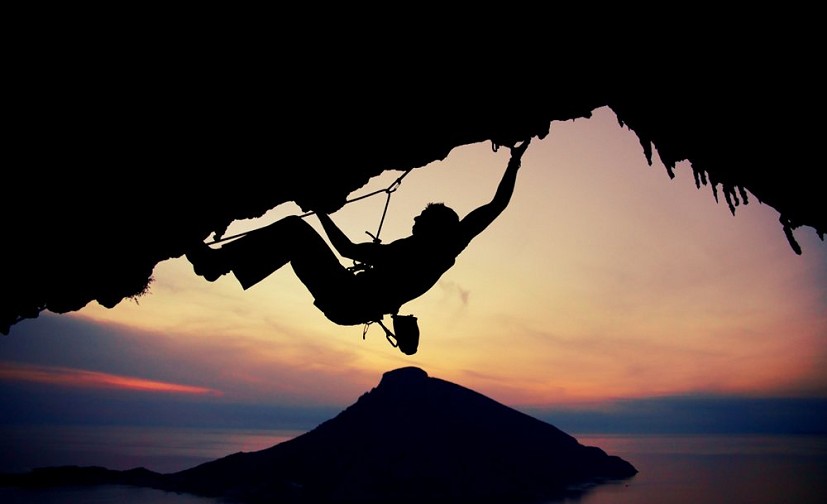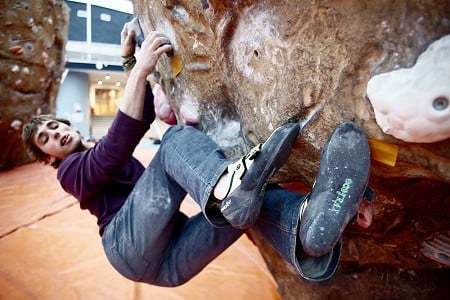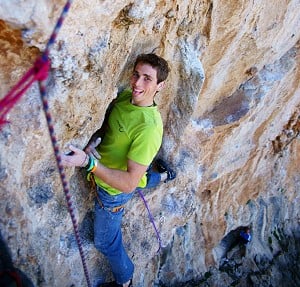Training to Part 1
This is the first of a series of training articles and is aimed at beginners or people who are operating in the low grades and wish to improve (Approximate grade range of around UK Diff - Severe, Sport grade F3 - 4 or bouldering grade VB / UK Tech 4c).
The next articles in the series will be aimed at climbers operating at higher levels, increasing as the series progresses.
So you've entered the world of rock climbing now and you can't shake the urge to go climbing more and more. I am sorry to have to tell you this... but it's over... your life as a normal, everyday person has gone! Climbers come in many shapes and sizes, but they are far from normal. The only thing you can do now is sit back and watch as your life slowly becomes engulfed by this crazily obsessive activity they call rock climbing!
If you are reading this, you obviously have an interest in improving your skills as a rock climber and you have very likely already decided that in order to do this, you are going to have to invest a bit more of a conscious effort into your daily routine at the wall. Acknowledging the fact that structure will help you improve is the first stage to becoming a better climber.
For the purpose of this article we are going to use an imaginary character; Tommy Toprope. Tommy is an example of a typical climber who would benefit from the training and exercises I am about to go into.

Occupation: Self-Employed Imaginary Character
Been climbing for: 2 months; once or twice a week
Personal Bio: I've only just started climbing, mainly pottering about on f3's, 4's and attempting 5's at the local wall. I have looked into learning to lead soon but not sure if I'm ready for that yet. Really keen to improve my climbing now, feel that I am not climbing as well as I could and reckon that a little direction as to what I should be doing when I come into the wall could help. All the cool looking climbs are 6b, so that's what I am aiming for!
How are we going to get Tommy up those 6b's?
When you first start climbing, there are two big areas that always need to be addressed more than anything else. These are: Footwork and Body Positioning.

Footwork – The Basics
Your climbing shoe consists of several main parts:
- Toe
- Inside Edge
- Outside Edge
- Heel
Knowing these parts and when to use them is essential to good technique and you must be aware of them when you are climbing. If you watch a typical beginner climber, he/she will often place their entire foot on a hold rather than specifically choosing one part of the shoe.
This is very bad technique because:
It restricts good contact of shoe rubber on the hold making you more likely to slip.
It restricts the range of movement you get with placing your foot precisely on a hold.
You don't get the same height from standing on the hold.
As you progress as a climber, the feet become increasingly more important and if you focus on them early on in your development, you will be better prepared for when footwork is essential to success.
Exercise Drills to Improve Footwork

This is incredibly simple and is a perfect addition to your warm-up and warm-down routine. All you need to do is find an easy wall to traverse on; it must have plenty of positive handholds and lots of varying sizes of footholds to practice your footwork on. Traverse for 10 minutes, focusing on placing your feet precisely on each foothold. Look at which parts of the foothold you are using and try and choose an appropriate part of the shoe: toe, inside edge, outside edge or heel? (The heel is an advanced technique that we will look at in more depth in the next article.)
Cork Game (Not just for kids!)
Again, another incredibly simple exercise, and a good excuse to go drinking (You've got to get the corks from somewhere right!). Place a number of corks on footholds along a vertical or slabby traverse wall. Now try to traverse the wall using all the footholds with corks on without knocking the corks over.
Feet on Features (Some say the ultimate footwork trainer)
Features are the moulded parts of walls built in to the panels. They are designed to emulate real rock as much as possible and therefore are incredibly useful for practising footwork, because there is nothing better than outdoor climbing to improve your technique.
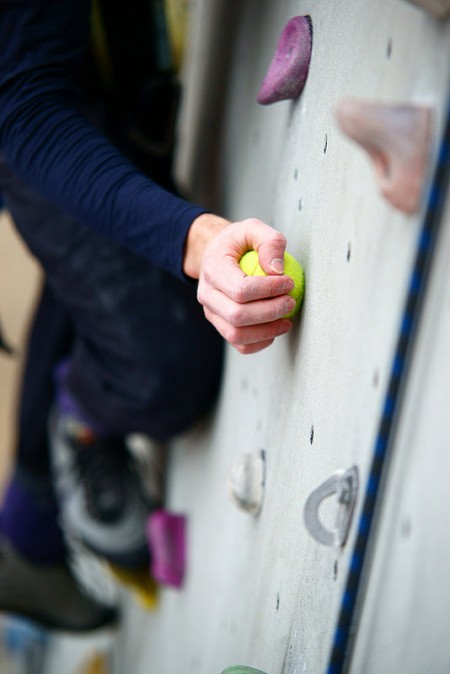
Body Positioning – The Basics
Understanding the position of your body on the wall is an essential technique to develop early so when you start hitting harder grades you won't be held back as much by technical issues such as balance, co-ordination, sequence reading and even strength and endurance, as having good body positioning improves efficiency whilst climbing.
The efficient use of your body on the wall relies mainly on your arms, legs and hips. If you watch good climbers at the wall, you will see that they are rarely out of balance and use extensions of their body such as their legs to counterbalance weight distribution. You will also see good climbers twisting their hips into the wall to give them better reach and more stability on harder moves.
There are a number of brilliant exercises to help you use your arms, legs and hips to their full potential.
Exercise Drills to Improve Body Position
Climbing with Tennis Balls
Simply hold a tennis ball in each hand and climb a slab. Because you are now unable to use your fingers to grasp the holds, you are limiting the amount of force your arms can apply to them, engaging your legs and hips automatically. Try and take mental notes about how your body moves during this exercise.
Climbing One Handed
Climbing one handed is the next stage up from "Tennis Balls". Choose one hand to use the whole way up the wall and don't alter! You will now have to encourage the use of your legs and hips even more and this time begin to use momentum to carry you through the moves. To increase difficulty again, just climb one handed with a tennis ball.
Climbing No Handed
Climbing no handed is obviously the most advanced of these three exercises. This will engage your arms, legs and hips as well as forcing you to use momentum through your legs to make high steps and awkward balancy movements. Your hands are allowed to palm on the flat wall for this, just make sure you don't inadvertently push against a hold. For all these exercises, its best to do them on a top rope wall!
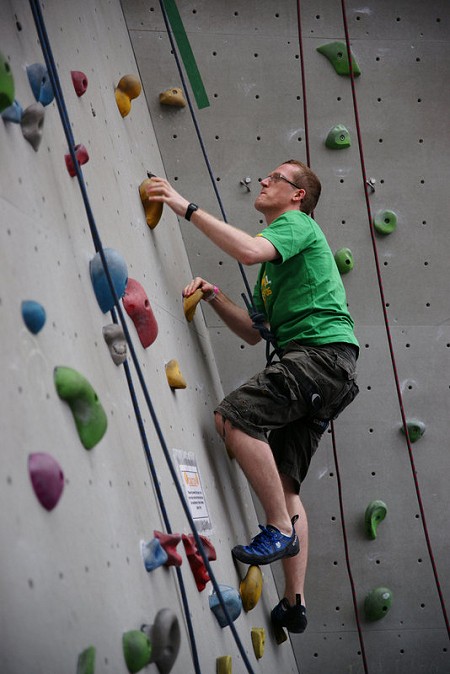
Becoming An All-Rounder (having more strengths than weaknesses)
To develop into a better climber, you need to have a good grounding in lots of different styles of climbing. This is important, because most climbers prefer climbing what they are naturally good at and don't challenge themselves on what they find difficult.
This happens to everyone and is most common among those who have been climbing for a long time and don't want to admit they have a weakness. I see this a lot with older climbers who may have had many years experience climbing slabs and vertical to slightly overhanging walls but refuse to touch the bouldering walls or challenge themselves on steeper ground.
There is however an easy way around this. When you go climbing at the wall, make sure you vary the style of routes and boulders you try, for example:
Route 1: Vertical Arete on Slopers
Route 2: Slightly Overhung Face on Crimps
Route 3: Very Overhanging Face on Jugs and Pockets
Route 4: Slabby Technicaly Arete on Crimps and Slopers
Route 5: Slabby Face on Pockets
Boulder 1: Overhanging on Pinches
Boulder 2: Vertical on Slopers
Boulder 3: Roof on Jugs
Boulder 4: Stepped Roof on Undercuts
Boulder 5: Slab on Crimps
At the end each of these training articles I will suggest a monthly training plan for a climber operating at the level specified in the article. As you progress through the grades, hopefully you can progress through the articles too.
The training plans do get slightly more specific as the level increases.
The first training plan:
Note: (VOH section in week three) Climbing extremely steep walls is very difficult, especially at first. Try and keep the wall as steep as possible, but still have a successful session. If you are struggling - first increase hold size, then decrease wall angle. You are working on steep climbing to recruit core muscles and learn steep technique.
Monthly Training Plan
| Weekly Sessions | Session 1 (Power/Endurance - 3x3's) |
Session 2 (Strength/Power - Boulders) |
Special Notes |
|---|---|---|---|
| Week 1 Focus - Technique on Slabs |
Warm Up (Heart Rate-Dynamic Stretches-Regeneration) 1 x Crimpy Slab Route 1 x Slopey Slab Route 1 x Arete (Slab or Vertical) 1 x Vertical Face Route 2 x Routes (Any) 2 x No Handed Slab Climbs (or tennis ball/1 handed) Cool Down (Regeneration-Static Stretches) |
Warm Up (Heart Rate-Dynamic Stretches-Regeneration) 2 x Crimpy Slab Boulder (3 x Attempts @ each) 2 x Slopey Slab Boulder (3 x Attempts @ each) 2 x Arete (Slab or Vertical) (3 x Attempts @ each) 2 x Vertical Boulder (3 x Attempts @ each) A few sets of the Cork Traverse game Cool Down (Regeneration-Static Stretches) |
Feet on features to make any routes or boulders harder |
| Week 2 Focus - Vertical (V) to Slightly Overhanging (SOH) Walls |
Warm Up (Heart Rate-Dynamic Stretches-Regeneration) 1 x Crimpy V/SOH Route 1 x Slopey V/SOH Route 1 x Arete V/SOH Route 1 x Pockety V/SOH Route 2 x Routes (Any) 2 x No Handed Slab Climbs (or tennis ball/1 handed) Cool Down (Regeneration-Static Stretches) |
Warm Up (Heart Rate-Dynamic Stretches-Regeneration) 2 x Crimpy V/SOH Boulder (3 x Attempts @ each) 2 x Slopey V/SOH Boulder (3 x Attempts @ each) 2 x Arete V/SOH Boulder (3 x Attempts @ each) 2 x Pockety V/SOH Boulder (3 x Attempts @ each) A few sets of the Cork Traverse game Cool Down (Regeneration-Static Stretches) |
Feet on features to make any routes or boulders harder |
| Week 3 Focus - Very Overhanging Walls (VOH) Walls |
Warm Up (Heart Rate-Dynamic Stretches-Regeneration) 4 x VOH Routes 2 x Routes (Any) 2 x No Handed Slab Climbs (or tennis ball/1 handed) Cool Down (Regeneration-Static Stretches) |
Warm Up (Heart Rate-Dynamic Stretches-Regeneration) 2 x Crimpy VOH Boulder (3 x Attempts @ each) 2 x Slopey VOH Boulder (3 x Attempts @ each) 2 x Arete VOH Boulder (3 x Attempts @ each) 2 x Pockety VOH Boulder (3 x Attempts @ each) A few sets of the Cork Traverse game Cool Down (Regeneration-Static Stretches) |
Feet on features to make any routes or boulders harder |
| Week 4 Focus - Anything You Want! |
Warm Up (Heart Rate-Dynamic Stretches-Regeneration) 6 x Routes (Any) 2 x No Handed Slab Climbs (or tennis ball/1 handed) Cool Down (Regeneration-Static Stretches) |
Warm Up (Heart Rate-Dynamic Stretches-Regeneration) 8 x Boulders (Any) (3 x Attempts @ each) A few sets of the Cork Traverse game Cool Down (Regeneration-Static Stretches) |
Feet on features to make any routes or boulders harder |
Robbie Phillips is a Climbing Coach based in Edinburgh. Robbie has produced a detailed series of coaching and training articles for us at UKClimbing.com - due to be published over the next few weeks.
Robbie - who has climbed F8b+ and onsighted muliple F8as - coaches several members of the British Junior Team and also gives private coaching at EICA Ratho.
"I don't claim to know everything there is to know about training and becoming a better rock climber - no-one really does for that matter - yet I am always learning and my enthusiasm for the sport has brought me very far indeed. I have travelled the world climbing outdoors and taking part in competitions and I have helped coach some of Britain's top youth competition climbers such as Natalie Berry, William Bosi and Angus Davidson."
- See his website for more details.
